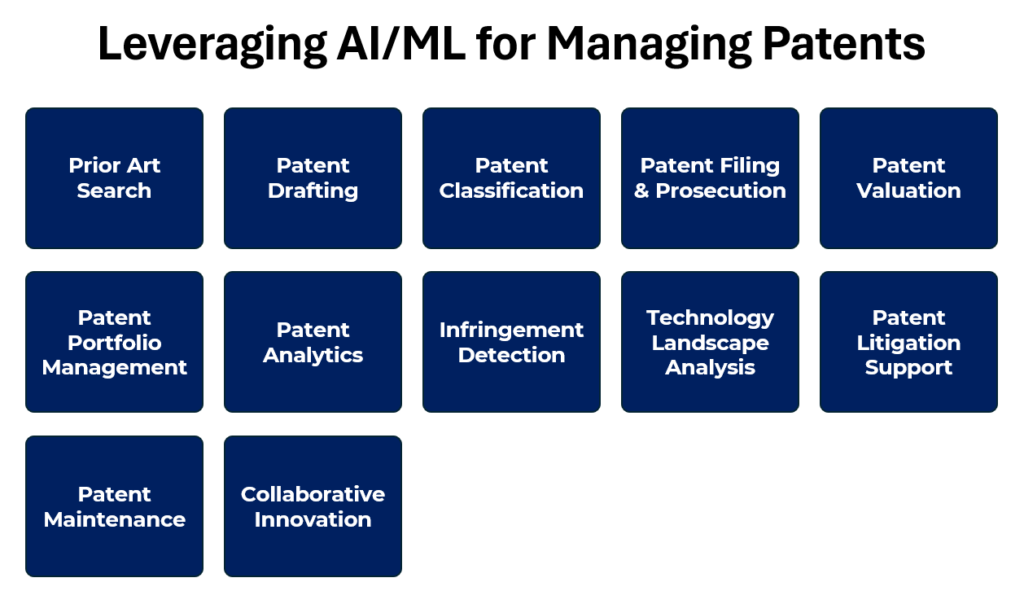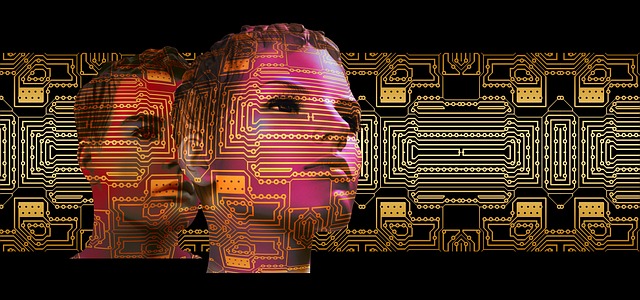Artificial Intelligence (AI) and Machine Learning (ML) can significantly impact patent management by automating and optimizing various tasks. By leveraging AI and ML in these areas, patent management processes can become more efficient, accurate, and proactive, ultimately enhancing the overall effectiveness of intellectual property management strategies. There are several applications and areas where AI/ML can be applied in patent management: Prior Art Search, Automated Patent Drafting, Patent Classification, Patent Valuation, Automated Patent Filing and Prosecution, Patent Portfolio Management, Patent Analytics, Infringement Detection, Technology Landscape Analysis, Patent Litigation Support, Automated Patent Maintenance and Collaborative Innovation Platforms.

A: Prior Art Search (Patent Searching)
Develop AI-powered search algorithms that can efficiently scan through vast amounts of existing patents and scientific literature to identify relevant prior art.
In a patent document, the discussion of prior art is typically found in the “Background” or “Description of Related Art” section. This section provides context and describes existing technologies or solutions related to the invention. The purpose is to establish the state of the art at the time of filing and highlight the novelty and inventiveness of the claimed invention. In this section, the patent applicant may discuss various documents, publications, patents, or other sources that represent the prior art. These references help define the problem that the invention aims to solve and demonstrate why the claimed invention is innovative. The prior art references may include: Published Patents: Previous patents that disclose relevant technologies or solutions. Scientific Papers: Academic papers and articles discussing related inventions or technologies. Industry Publications: Magazines, journals, or other publications within the relevant industry. Books: Relevant books discussing technologies or methods related to the invention. By citing prior art, the patent applicant aims to distinguish their invention from what already exists and emphasize the unique aspects of their contribution. It’s crucial for a patent examiner to evaluate the claimed invention against the existing prior art to determine its patentability.
Read More: Prior Art Search
B: Patent Drafting
Use NLP algorithms to assist inventors and patent attorneys in drafting patent applications by suggesting language, identifying relevant sections, and ensuring compliance with legal requirements.
Automating the drafting of patents involves a combination of advanced technologies, domain expertise, and careful consideration of legal requirements. (1) Have a thorough understanding of the specific industry, technology, and legal requirements relevant to the patent being drafted. Knowledge of patent law and regulations is crucial. (2) Gather relevant data, including technical information, prior art, and details about the invention. Utilize data processing techniques to organize and structure the information for analysis. (3) Implement NLP techniques to analyze and understand the language used in patent documents. This includes identifying key terms, concepts, and legal language specific to patent drafting. (4) Develop or leverage machine learning models to assist in various aspects of drafting, such as: Claim generation. Specification drafting. Identifying relevant prior art. (5) Apply semantic analysis to understand the context and meaning of terms used in patent documents. This helps in improving the precision of language used in patent drafts. (6) Incorporate rule-based systems to ensure compliance with legal and patent office guidelines. This involves enforcing specific rules related to patent drafting, formatting, and language.
Read More: Patent Drafting
C: Patent Classification
ML-based Classification Systems: Implement ML models to classify patents into relevant categories, making it easier to organize and search for patents based on their content.
AI/ML is being increasingly leveraged for patent classification to automate and enhance the categorization of patents into predefined classes or categories. Patent classification is a crucial step in organizing vast patent databases and improving search and retrieval processes. AI/ML technologies are transforming patent classification by improving accuracy, efficiency, and adaptability. Establishing clear OKRs, KPIs, and metrics helps organizations set specific goals, measure progress, and evaluate the success of their AI/ML-driven patent classification initiatives : (1) Increase efficiency in patent classification. (2) Achieve a reduction in average processing time per patent within specficied number of months. (3) Improve accuracy and consistency in patent classifications. (4) Attain a classification accuracy rate of certain % or higher as measured by an independent audit. (5) Enhance scalability for handling a growing number of patents. (6) Increase throughput to classify patents per day within the next quarter. (7) Achieve cost savings in patent classification efforts. Reduce the cost per patent classification by % over the next fiscal year. (8) Enable adaptability to changes in patent law and regulations. (9) Implement updates or changes to the classification rules within certain number of weeks of their announcement. (10) Facilitate better decision-making through accurate patent classifications. (11) Improve user satisfaction with the system, as measured by a certain increase in user feedback scores.
Read More: Patent Classification
D: Patent Valuation
Utilize predictive analytics models to assess the potential value of a patent based on various factors such as market trends, technology landscape, and litigation history.
AI/ML is increasingly being applied in the field of patent valuation to provide more accurate and data-driven assessments of the economic value of intellectual property. Patent valuation involves estimating the financial worth of patents based on various factors such as technological relevance, market potential, and competitive landscape. AI algorithms analyze the technological content of patents, considering factors such as citations, references, and the technical details within the documents. Provides insights into the significance of the patented technology in relation to industry trends and advancements. AI/ML helps in predicting potential risks and challenges associated with patents, allowing companies to proactively address issues. AI/ML technologies in patent valuation empower companies to assess the economic value of their intellectual property more accurately, enabling strategic decision-making and portfolio optimization. Platforms like PatSnap, IPlytics, and Cipher demonstrate how these technologies are integrated into comprehensive patent analytics solutions.
Read More: Patent Valuation
E: Patent Filing and Prosecution
Implement AI-driven systems to automate the patent filing and prosecution process, reducing manual workload and ensuring compliance with regulatory requirements.
AI/ML technologies are transforming patent prosecution by automating routine tasks, providing valuable insights, and improving the overall efficiency and effectiveness of the process. Companies like Docket Alarm, InQuartik, and Legal Robot are at the forefront of integrating AI into patent prosecution workflows. AI/ML technologies are increasingly playing a role in the patent prosecution process, helping patent professionals streamline workflows, enhance efficiency, and make data-driven decisions. Patent prosecution involves interactions with patent offices, including the preparation, filing, and examination of patent applications.
Read More: Patent Filing and Prosecution
F: Patent Portfolio Management
Develop AI-powered decision support systems to assist IP managers in optimizing their patent portfolios, identifying opportunities for licensing, divestment, or acquisition.
Patent Portfolio Management (PPM) refers to the strategic and systematic administration of a collection of patents owned by an individual, company, or organization. The primary goal of patent portfolio management is to optimize the value, effectiveness, and competitiveness of the intellectual property (IP) assets represented by patents. This involves various activities aimed at acquiring, developing, maintaining, and leveraging patents to achieve strategic business objectives. AI/ML provides insights that help organizations make informed and strategic decisions regarding their patent portfolios, including which patents to maintain, divest, or acquire. Automation through AI/ML tools streamlines portfolio management tasks, improving efficiency and allowing IP professionals to focus on high-value activities. AI-driven competitive intelligence ensures that organizations are aware of their competitors’ activities, allowing them to position their portfolios for a competitive advantage. Analysis of technology trends and landscape ensures that the patent portfolio aligns with current and future innovations, supporting organizational goals. AI helps identify opportunities for licensing, partnerships, or other forms of monetization, maximizing the financial value of the patent portfolio.
Read More: Patent Portfolio Managament
G: Patent Analytics
Apply ML techniques to mine patent databases for valuable insights, trends, and patterns. Visualization tools can then present this information in a user-friendly format.
Patent analytics refers to the use of data analysis, statistical techniques, and machine learning to extract valuable insights and information from patent-related data. This field combines technology, legal understanding, and data science to provide meaningful interpretations of large volumes of patent information. The goal of patent analytics is to support decision-making processes, identify trends, assess the competitive landscape, and derive strategic insights related to intellectual property.
Read More: Patent Analytics
H: Infringement Detection
Implement ML algorithms to detect potential patent infringements by analyzing large datasets, including product descriptions, technical documents, and patent claims.
Infringement detection, in the context of patents, refers to the process of identifying instances where a product, technology, or process may be using or implementing patented inventions without proper authorization from the patent holder. Patent infringement occurs when someone else makes, uses, sells, or offers for sale a product or process that falls within the scope of the claims of a valid and enforceable patent. The patent holder has the exclusive right to prevent others from engaging in such activities without their permission. AI/ML is leveraged for infringement detection in the field of intellectual property to identify potential instances of patent infringement. Detection of infringement involves analyzing large datasets of patents and related information to identify whether a product, process, or technology may be infringing on existing patents.
Read More: Infringement Detection
I: Technology Landscape Analysis
Use ML-based topic modeling to analyze the technology landscape, identify emerging trends, and evaluate the competitive landscape within specific technology domains.
Technology landscape analysis refers to the systematic examination and assessment of the current state and trends within a specific technological domain or field. The goal of technology landscape analysis is to gain a comprehensive understanding of the various technologies, innovations, key players, research trends, and potential areas for development within a given area of interest. This analysis is valuable for decision-making, strategic planning, and innovation management. AI/ML is leveraged for technology landscape analysis to provide organizations with insights into emerging trends, competitive intelligence, and strategic opportunities within a specific technological domain. Technology landscape analysis involves examining the patent landscape, scientific literature, and other relevant data sources to identify patterns, trends, and potential areas for innovation.
Read More: Technology Landscape Analysis
J: Patent Litigation Support
Develop models to predict the likelihood of success in patent litigation cases based on historical data, legal precedents, and case outcomes.
Patent litigation support refers to the assistance provided to parties involved in legal disputes or litigation related to patents. Patent litigation is a legal proceeding that typically arises when a party believes that their patent rights have been infringed upon by another party. The patent holder (plaintiff) may file a lawsuit against the alleged infringer (defendant) to seek legal remedies, such as injunctions, damages, or licensing agreements. Patent litigation can be complex, involving legal, technical, and procedural aspects. Patent litigation support services are designed to help parties navigate the complexities of the legal process and build a strong case.
Read More: Patent Litigation Support
K: Patent Maintenance
Implement AI-driven reminder systems to keep track of important patent deadlines, maintenance fees, and regulatory compliance requirements.
AI/ML is increasingly leveraged for automating patent maintenance tasks to enhance efficiency, reduce costs, and ensure compliance with legal requirements. Patent maintenance involves various activities, including monitoring deadlines, updating documentation, and managing renewal processes. Deadline Monitoring and Alerts: AI algorithms analyze patent databases and legal documents to track maintenance deadlines, sending automated alerts to notify patent holders of upcoming deadlines. Reduces the risk of missed deadlines, helping organizations stay in compliance with maintenance requirements. Document Management and Updates: AI-powered document management systems automatically update patent documentation, ensuring that records are accurate and up-to-date. Streamlines administrative tasks related to patent maintenance, reducing manual effort and improving accuracy. Fee Estimation and Budgeting: Machine learning models analyze historical data to estimate maintenance fees, aiding organizations in budgeting and financial planning for patent maintenance. Provides cost predictability and assists in optimizing budget allocations for patent maintenance. Risk Assessment for Abandonment: AI tools assess the risk of patent abandonment by considering factors such as market relevance, commercial value, and legal considerations. Helps organizations prioritize patents for maintenance based on their strategic importance. Automation of Routine Tasks: AI automates routine tasks involved in patent maintenance, such as data entry, form completion, and communication with patent offices. Increases operational efficiency and reduces the likelihood of errors associated with manual tasks.
Read More: Patent Maintenance
L: Collaborative Innovation
Integrate AI capabilities into collaborative platforms that facilitate innovation, enabling inventors and researchers to collaborate more effectively during the patent creation process.
Collaborative innovation platforms leverage AI/ML to enhance various aspects of the innovation lifecycle, from idea generation to project management. These platforms facilitate collaboration among diverse teams, improve the innovation process, and harness the power of data-driven insights. Idea Generation and Crowdsourcing: AI algorithms analyze historical data, user behavior, and trends to suggest relevant topics for ideation. Machine learning models can also evaluate and rank submitted ideas based on various criteria. Example: Spigit uses AI to analyze user interactions, identify patterns, and suggest challenges that align with organizational goals. Enhances the quality and relevance of ideas by leveraging data-driven insights, making ideation more efficient. Innovation Management and Workflow Optimization: AI/ML is applied to streamline innovation workflows, automate routine tasks, and optimize resource allocation. Predictive analytics can help in project planning and risk assessment. Brightidea incorporates machine learning to analyze project data, predict project success, and recommend improvements to innovation processes. Improves operational efficiency, accelerates project timelines, and enhances overall innovation management.
Read More: Collaborative Innovation
Author / Speaker Introduction: An accomplished professional with over two decades of expertise in Intellectual Property and Software Technologies, he has served clients in patent prosecution, analytics, portfolio management, and innovation. His passion lies in exploring and applying technologies that enhance innovation and intellectual property outcomes. As Vice President at Wells Fargo, he played a crucial role in managing tech start-ups for innovation-led digital transformation. With a background in Infosys, Capgemini, and Wipro, he brings extensive experience in innovation and intellectual property management. He holds an MBA from IIMC and engineering degrees from DCE and BITS Pilani. He has co-authored a compelling book on AHP and its application in decision engineering, published by Springer Verlag, UK, garnering over 1450 citations, as of 2023. As a visiting faculty member, he has also delivered numerous courses on AI/ML. Today, he shares insights into AI/ML and IP tech start-ups, elucidating how AI/ML transforms patent management processes.
Abstract: The talk emphasizes the transformative impact of Artificial Intelligence (AI) and Machine Learning (ML) on patent management. By automating and optimizing various tasks, these technologies enhance efficiency, accuracy, and proactivity in intellectual property management strategies. The applications of AI/ML in patent management include Prior Art Search, Automated Patent Drafting, Patent Classification, Patent Valuation, Automated Patent Filing and Prosecution, Patent Portfolio Management, Patent Analytics, Infringement Detection, Technology Landscape Analysis, Patent Litigation Support, Automated Patent Maintenance, and Collaborative Innovation Platforms. The discussion is centered on how emerging tech start-ups are leveraging AI/ML to develop innovative solutions for these aspects of patent management.
Download Presentation




